Read Maui, Part 1
Before coming to Maui, the only agricultural product I associated with the island was the Maui onion. And then only because they make Maui Style onion-flavored potato chips. When I say "they make," I am referring to the Frito-Lay division of PepsiCo. in Plano, Texas. (If you want to find any of their "Hometown Favorites" products, use their nifty item locator.) According to the ingredients list, there is indeed some Maui onion powder in the Maui Onion-flavored chips. It's the 13th of 15th ingredient listed, ahead of Hydrolyzed Proteins and Caramel Color, but behind Corn Maltodextrin, Monosodium Glutamate, Malic Acid, and that classic and most sacred of culinary components, "Natural Flavor."
I don't necessarily have a problem with eating mass-processed junk food. After all, Camille and I stayed in early on our first night, our jet lag-induced slumber interrupted by a dinner that consisted of a bag of Natural Flavor and Maui Onion Powder. But there is something to eating fresh and local, as I found out.
Of course, this is the tourist's dilemna: to find that definitively, quintessentially local thing before it gets dolled up, appropriated, outsourced, and repackaged as Totally Local, Brah! Some recreations are worthwhile (like, say, a luau), but others, not so much (floral golf ball 3-pack). What I'll take away the most from Maui is a sense of what it truly means to go local, at least as far as food is concerned. Nevermind where the purveyors, chefs, and waiters came from. Much of the best stuff Camille and I ate was from the land and waters of Maui.
Imagine that, eating food before it gets packed and shipped off to Plano.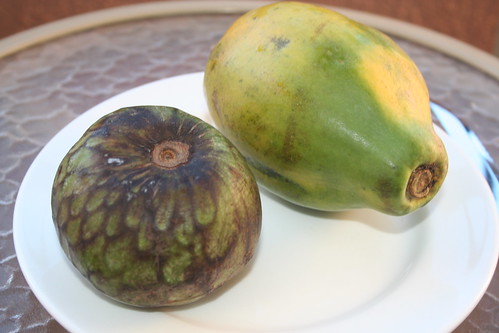
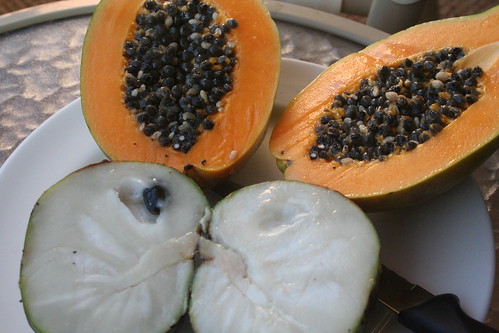 I was never really a farmer's market guy before. I simply didn't understand the difference between what Albertson's, Ralph's, and Von's featured in their produce section versus stuff that had not traveled thousands of miles. Before our trip to Hawaii, I had some gnarly peaches and pears that came from my local Los Angeles Albertson's via Chile. Certainly, I've had perfectly decent fruit from faraway lands before, but it's easy to accept "pretty good" when you haven't had "frakking fantastic" on a semi-normal basis. It helps when that frakking fantastic fruit is exotic and tropical, as with the cherimoya and papaya we procured from the weekly Maui Swap Meet. (Also picked up some cool and, yes, local t-shirts.)
I was never really a farmer's market guy before. I simply didn't understand the difference between what Albertson's, Ralph's, and Von's featured in their produce section versus stuff that had not traveled thousands of miles. Before our trip to Hawaii, I had some gnarly peaches and pears that came from my local Los Angeles Albertson's via Chile. Certainly, I've had perfectly decent fruit from faraway lands before, but it's easy to accept "pretty good" when you haven't had "frakking fantastic" on a semi-normal basis. It helps when that frakking fantastic fruit is exotic and tropical, as with the cherimoya and papaya we procured from the weekly Maui Swap Meet. (Also picked up some cool and, yes, local t-shirts.)
I'd never even heard of a cherimoya before this trip. It's a custard apple with a sweet, semi-pungent smell, and soft, sweet, white flesh that truly has the texture of soft custard. I spent the entire trip in Maui hoping to get a taste of fresh passion fruit, but the cherimoya sated my exotic fruit desires. Frankly, it's the damnedest thing I've ever eaten. It's Jell-o grown by a tree. And you know what they say about Jell-o.
By the way, you can thank Google for Calimoya, a cherimoya, passion fruit, avocado, and dragon fruit grower in the Santa Barbara area. Expensive, but will ship 2-day UPS when the fruits are in season. Have I overused the phrase "frakking fantastic" yet? One of the most popular ways to take in the local scenery of Maui is to drive the road to Hana, a twisting road along Maui's eastern coast that includes lots of lush greenery, hiking trails, waterfalls, and fruit stands that operate on the honor system. Sadly, I did not snap a picture of one of these fruit stands that consist simply of a shelf or two of produce, a menu listing prices, and a lock box with a slot for money. The best spur-of-the-moment purchase on the trip was at the Halfway to Hana stand (which also contained people -- boo), where we'd stopped for their much-lauded banana bread. A free sampling of toasted coconut was placed in front of me as my purchase was rung up. I'm not a huge coconut fan, especially dried coconut, but this stuff was something else. The perfect balance of that nutty coconut flavor with (light brown?) sugar. The banana bread was really good, but this sweetened toasted coconut stuff alone was worth half the trip to Hana.
One of the most popular ways to take in the local scenery of Maui is to drive the road to Hana, a twisting road along Maui's eastern coast that includes lots of lush greenery, hiking trails, waterfalls, and fruit stands that operate on the honor system. Sadly, I did not snap a picture of one of these fruit stands that consist simply of a shelf or two of produce, a menu listing prices, and a lock box with a slot for money. The best spur-of-the-moment purchase on the trip was at the Halfway to Hana stand (which also contained people -- boo), where we'd stopped for their much-lauded banana bread. A free sampling of toasted coconut was placed in front of me as my purchase was rung up. I'm not a huge coconut fan, especially dried coconut, but this stuff was something else. The perfect balance of that nutty coconut flavor with (light brown?) sugar. The banana bread was really good, but this sweetened toasted coconut stuff alone was worth half the trip to Hana.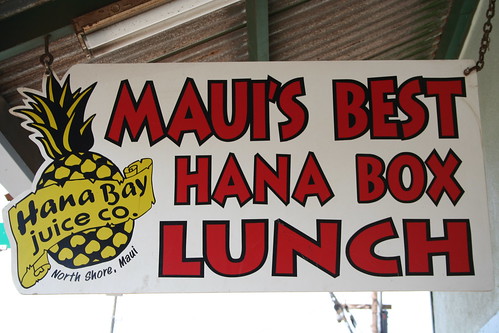 However, unless you're satisfied grazing on mysteriously orphaned fruit at a fruit stand, you'll want to grab a picnic lunch before embarking on the Hana trip. We hit up the Hana Bay Juice Co. in Paia, which has scrumptious sandwiches and really tasty smoothies. They even offer coolers and ice packs. What I remember most about the sandwiches other than them tasting really good was the bread. Sure, I suppose eating a sandwich on a beautiful peninsula in paradise helps, but all the great sandwiches that stick out in my mind have had one thing in common: perfect bread that's crunchy on the outside, soft and moist on the inside, and holds up to the rigors of sandwich eating without spilling its innards everywhere. Camille had a smoked salmon sandwich with cream cheese and capers. I had roast beef. Good ingredients all around, but again, when it comes to sandwiches, it's all about the bread.
However, unless you're satisfied grazing on mysteriously orphaned fruit at a fruit stand, you'll want to grab a picnic lunch before embarking on the Hana trip. We hit up the Hana Bay Juice Co. in Paia, which has scrumptious sandwiches and really tasty smoothies. They even offer coolers and ice packs. What I remember most about the sandwiches other than them tasting really good was the bread. Sure, I suppose eating a sandwich on a beautiful peninsula in paradise helps, but all the great sandwiches that stick out in my mind have had one thing in common: perfect bread that's crunchy on the outside, soft and moist on the inside, and holds up to the rigors of sandwich eating without spilling its innards everywhere. Camille had a smoked salmon sandwich with cream cheese and capers. I had roast beef. Good ingredients all around, but again, when it comes to sandwiches, it's all about the bread.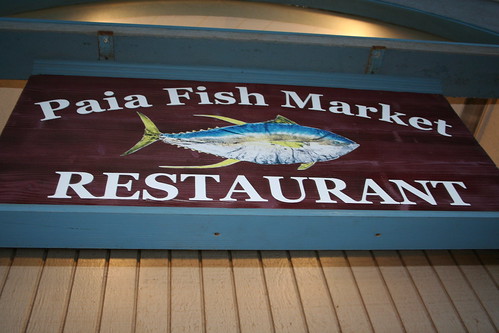 Returning from Hana, we stopped in Paia again to eat at Paia Fish Market. It's a casual, lively place that features some strong European accents from both customers and employees. The vibe is that of a quaint, all-night diner, with the cook having to shout order numbers over the loud din of conversation at shared tables.
Returning from Hana, we stopped in Paia again to eat at Paia Fish Market. It's a casual, lively place that features some strong European accents from both customers and employees. The vibe is that of a quaint, all-night diner, with the cook having to shout order numbers over the loud din of conversation at shared tables.
In terms of their food, they feature a lot of fresh and tasty fish. I had ono tacos. The slaw of roughage in the tacos was, as you can see, a little overwhelming, but it was all good. A fine, messy meal. Bonus points for heating the tortilla so it was slightly crunchy. Camille's opah sauteed in butter, white wine, lemon, and garlic was good if a tad too well done. (Fine woman that she is, she chose the meaty opah in anticipation that it'd be overcooked, knowing it'd retain some moistness.) 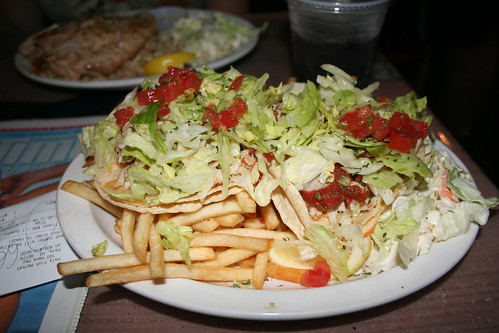
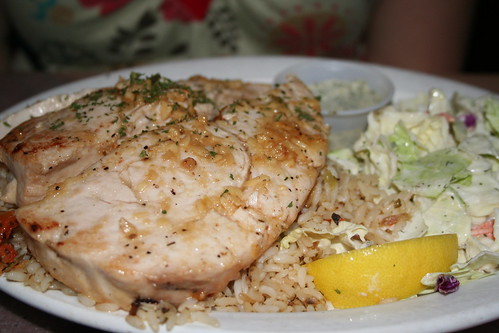 Okay, so ono fish tacos aren't quintessentially Hawaiian. And God knows who was the first to saute fish in garlic, butter, white wine, and lemon. But there isn't easy access to stuff like this in Los Angeles, so, in my mind, it's explicitly local to these islands. (Nevermind the fries and rice accompanying our dishes.)
Okay, so ono fish tacos aren't quintessentially Hawaiian. And God knows who was the first to saute fish in garlic, butter, white wine, and lemon. But there isn't easy access to stuff like this in Los Angeles, so, in my mind, it's explicitly local to these islands. (Nevermind the fries and rice accompanying our dishes.)
No, the truly local part of our trip didn't begin until our tours into Kula.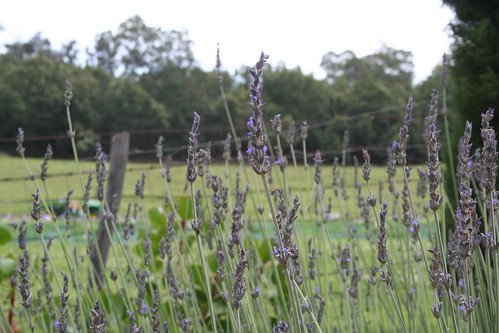 The Ali'i Kula Lavender Farm is a nifty place to start. (Or the 'AKL.' Not to be confused with the ATL.) Incidentally, Ali'i is a Hawaiian term for royalty or noble class. And the dude who started the farm goes by the name of Ali'i. Seriously, who names their kid "royalty?" Other than Michael Jackson? Moving on...
The Ali'i Kula Lavender Farm is a nifty place to start. (Or the 'AKL.' Not to be confused with the ATL.) Incidentally, Ali'i is a Hawaiian term for royalty or noble class. And the dude who started the farm goes by the name of Ali'i. Seriously, who names their kid "royalty?" Other than Michael Jackson? Moving on...
The AKL is 10.5 acres of serene, manicured gardens containing something like a kajillion types of lavender. Tours range from the free, self-guided variety (highly recommended) to a $12, 30-minuted guided walk and, lastly, an exclusive golf cart tour with grower Alii Chang. This last one is limited to five people per day, and for $25 bucks you'll have a dude whose first name is literally royalty talk your head off about a kajillion types of lavender.
The place is beautiful, don't get me wrong. There's something kind of mystical about Kula, all the lush, green rural land halfway up the slopes of a dormant volcano, and this farm is a fine place to stop and take it all in. But you can certainly do it for free with one of their photocopied guides to lavender, which we did. Camille and I had fun eating lavender scones and drinking lavender tea on the AKL Farm's quaint patio after perusing the many lavender-infused items in the gift shop. I recently used some AKL Farm lavender pepper to coat the skin on some pan-roasted chicken and also on shrimp, and it was good stuff -- a wise investment.
As for the scones... well, okay, they taste like scones. The lavender flavor in them could easily by in my mind. No, a more palpable and enjoyable way to eat the scones is to slather them with lavender lilikoi jelly. It's more than a dollar per ounce and we bought two jars. Sweet, tangy, and fragrant, it made the scones a delectable experience. Washing it down with lavender tea, which certainly does not skimp on the lavender, made for a wonderfully calming afternoon.
Lavender, by the way, is native to the Mediterranean, not Hawai'i. Strictly speaking, next to nothing is native to Hawai'i except dried lava. But one of the fantastic things about Hawaii that's very evident in Maui -- and especially in Kula -- is the fertility of the land. I couldn't really tell you what a microclimate is (though I'd hazard a guess that it means "really small climate"), but they got 'em in spades in Maui. Which is a good thing for farmers.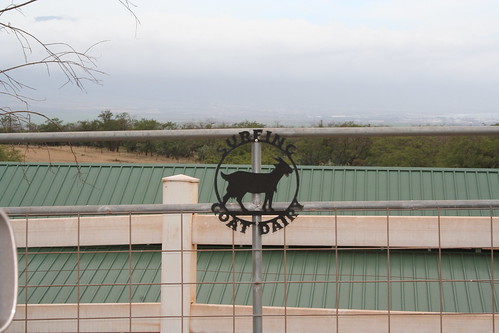 The Surfing Goat Dairy is a fun little diversion. It was founded by two German expatriates (seriously, what is it about Maui that attracts the Europeans?), but we were toured around by a kindly, portly, limping Polynesian lady wearing a muumuu. She reminded me of the cafe owner in 50 First Dates. Hopefully, no one has said this to her face, but hey, I don't have a lot of pop culture references for kindly, big-boned Polynesians.
The Surfing Goat Dairy is a fun little diversion. It was founded by two German expatriates (seriously, what is it about Maui that attracts the Europeans?), but we were toured around by a kindly, portly, limping Polynesian lady wearing a muumuu. She reminded me of the cafe owner in 50 First Dates. Hopefully, no one has said this to her face, but hey, I don't have a lot of pop culture references for kindly, big-boned Polynesians.
The tour is short and sweet: see milking equipment, see baby goats, see adult goats, see pot-bellied pig humping rocks, taste cheese. If we had the means to keep it cool, we would have definitely bought some cheese to bring home. Not to belabor the point, but all the cheese was super fresh, and in their relatively short time as a dairy, the Surfing Goat has certainly mastered ways to combine their creamy cheeses with some local flavors, like the lilikoi quark.
What I really liked more than anything else was realizing just how small an operation the Surfing Goat Dairy is. It really is just one family with a few hired hands, and in this day and age, it's admirable to see them pull that off. They even resist selling their older goats for meat, simply letting them retire to pasture for the rest of their natural lives. I have no idea if there are undiscovered local farms in the Los Angeles area, but I sure hope so, because it's something I'd definitely support.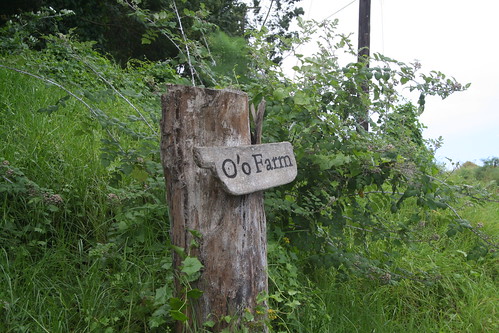 The lavender farm features a very specific food chain. If you're not interested in any type of lavender, much less countless variations of them, but you are interested in really good food and the food chain that supports it, then you owe it to yourself to take the tour and have lunch on the O'o Farm (which is literally down the road from the AKL). It's an organic farm growing much of the produce served at two of Maui's acclaimed, upscale restaurants, Pacific'O and I'O. They'll take you around and teach you about their organic practices, let you taste stuff straight out of the ground, and then serve you a lunch prepared almost entirely with ingredients they've grown (the exceptions being bread and fish, which cannot be grown in dirt).
The lavender farm features a very specific food chain. If you're not interested in any type of lavender, much less countless variations of them, but you are interested in really good food and the food chain that supports it, then you owe it to yourself to take the tour and have lunch on the O'o Farm (which is literally down the road from the AKL). It's an organic farm growing much of the produce served at two of Maui's acclaimed, upscale restaurants, Pacific'O and I'O. They'll take you around and teach you about their organic practices, let you taste stuff straight out of the ground, and then serve you a lunch prepared almost entirely with ingredients they've grown (the exceptions being bread and fish, which cannot be grown in dirt).
The tour is really informative and the meal is great, deliberately kept simple to highlight the assorted harvest. The place attracts a really interesting crowd, too, from agriculture and nutrition students to foodies on the hunt. The tour/lunch is limited to about 15-20 people, so do make a reservation early. It's a little pricey at $50 a person, but this is a whole lot more than gawking at lavender. This is food at its most elemental. The label "organic" gets tossed around so easily, so to see a living, breathing example of an organic farm is incredibly edifying. I had no idea what "compost tea" was, but I do now, and I think I'm a better eater for it. To see everything go from the ground to the table is more fun than I could have imagined. Beets never tasted so good.
Plus, how often do you get a chef de cuisine from a highly rated restaurant to cook everything for you on an outdoor, wood-burning stove? Seriously, how cool is that?
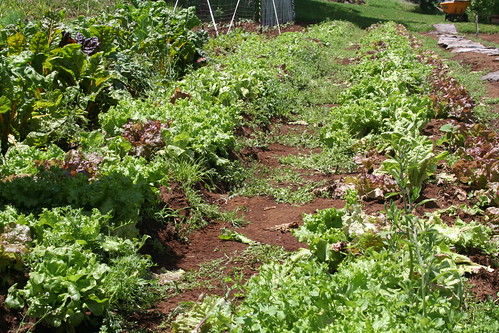


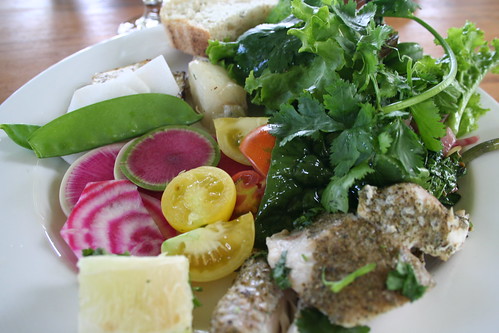
Coming soon in Maui, Part 3: The other end of the O'o Farm food chain, plus the stuff I couldn't neatly tie into Parts 1 or 2.
Hana Bay Juice Co.
111A Hana Highway
Paia, HI 96779
(808) 579-8686
Paia Fish Market
110 Hana Highway
Paia, HI 96779
(808) 579-8030
paiafishmarket.com
Ali'i Kula Lavender Farm
1100 Waipoli Road
Kula, HI 96790
(808) 878-3004
www.aliikulalavender.com
Surfing Goat Dairy
3651 Omaopio Road
Kula, HI 96790
(808) 878-2870
surfinggoatdairy.com
O'o Farm (reservation required)
Waipoli Road
Kula, HI 96790
(808) 667-4341
www.oofarm.com
19 June 2008
Maui, Part 2: Going Native
Subscribe to:
Post Comments (Atom)
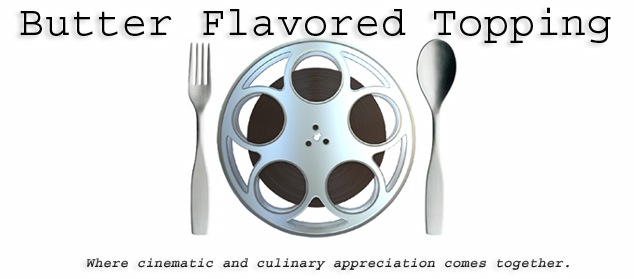






4 comments:
The custard apple was my best fruit growing up in Cape Town, South Africa.I do miss it so! I have never eaten one while residing in the US. I remember the sweet creamy taste and biting into it with the juice running down my chin. I remember that at one stage, I ate nothing else but the custard apple and seeing your picture of it, just brought back those sweet recollections. I wish I could have one right now!
The food and pictures look terrific!
Denise
http://WineFoodPairing.blogspot.com
@nazarina a
Yeah, I was really yearning for a cherimoya when I returned to CA. Thankfully, it was the tail end of cherimoya season and my local farmer's market had a few. Now I'll just have to wait till next year... or, you know, go back to Hawaii.
Thanks, Denise! I love me DSLR.
Post a Comment